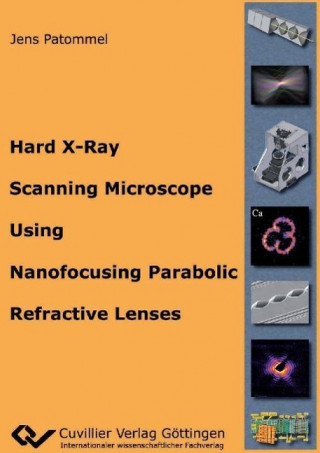
Kód: 13414664
Hard X-Ray Scanning Microscope Using Nanofocusing Parabolic Refractive Lenses
Autor Jens Patommel
Hard x rays come along with a variety of extraordinary properties which make them an excellent probe for investigation in science, technology and medicine. Their large attenuation length in matter opens up the possibility to use h ... celý popis
- Jazyk:
 Angličtina
Angličtina - Vazba: Brožovaná
- Počet stran: 164
Nakladatelství: Cuvillier Verlag, 2011
- Více informací o knize

Mohlo by se vám také líbit
Darujte tuto knihu ještě dnes
- Objednejte knihu a zvolte Zaslat jako dárek.
- Obratem obdržíte darovací poukaz na knihu, který můžete ihned předat obdarovanému.
- Knihu zašleme na adresu obdarovaného, o nic se nestaráte.
Více informací o knize Hard X-Ray Scanning Microscope Using Nanofocusing Parabolic Refractive Lenses
Nákupem získáte 72 bodů
 Anotace knihy
Anotace knihy
Hard x rays come along with a variety of extraordinary properties which make them an excellent probe for investigation in science, technology and medicine. Their large attenuation length in matter opens up the possibility to use hard x-rays for non-destructive investigation of the inner structure of specimens. Medical radiography is one important example of exploiting this feature. Since their discovery by W. C. Röntgen in 1895, a large variety of x-ray analytical techniques have been developed and successfully applied, such as x-ray crystallography, reflectometry, fluorescence spectroscopy, x-ray absorption spectroscopy, small angle x-ray scattering, and many more. Each of those methods reveals information about certain physical properties, but usually, these properties are an average over the complete sample region illuminated by the x rays. In order to obtain the spatial distribution of those properties in inhomogeneous samples, scanning microscopy techniques have to be applied, screening the sample with a small x-ray beam. The spatial resolution is limited by the finite size of the beam. The availability of highly brilliant x-ray sources at third generation synchrotron radiation facilities together with the development of enhanced focusing x-ray optics made it possible to generate increasingly small high intense x-ray beams, pushing the spatial resolution down to the sub-100nm range. During this thesis the prototype of a hard x-ray scanning microscope utilizing microstructured nanofocusing lenses was designed, built, and successfully tested. The nanofocusing x-ray lenses were developed by our research group of the Institute of Structural Physics at the Technische Universität Dresden. The prototype instrument was installed at the ESRF beamline ID 13. A wide range of experiments like fluorescence element mapping, fluorescence tomography, x-ray nano-diffraction, coherent x-ray diffraction imaging, and x-ray ptychography were performed as part of this thesis. The hard x-ray scanning microscope provides a stable x-ray beam with a full width at half maximum size of 50-100nm near the focal plane. The nanoprobe was also used for characterization of nanofocusing lenses, crucial to further improve them. Based on the experiences with the prototype, an advanced version of a hard x-ray scanning microscope is under development and will be installed at the PETRA III beamline P06 dedicated as a user instrument for scanning microscopy. This document is organized as follows. A short introduction motivating the necessity for building a hard x-ray scanning microscope is followed by a brief review of the fundamentals of hard x-ray physics with an emphasis on free-space propagation and interaction with matter. After a discussion of the requirements on the x-ray source for the nanoprobe, the main features of synchrotron radiation from an undulator source are shown. The properties of the nanobeam generated by refractive x-ray lenses are treated as well as a two-stage focusing scheme for tailoring size, flux and the lateral coherence properties of the x-ray focus. The design and realization of the microscope setup is addressed, and a selection of experiments performed with the prototype version is presented, before this thesis is finished with a conclusion and an outlook on prospective plans for an improved microscope setup to be installed at PETRA III.
 Parametry knihy
Parametry knihy
721 Kč
- Plný název: Hard X-Ray Scanning Microscope Using Nanofocusing Parabolic Refractive Lenses
- Autor: Jens Patommel
- Jazyk:
 Angličtina
Angličtina - Vazba: Brožovaná
- Počet stran: 164
- EAN: 9783869556147
- ISBN: 3869556145
- ID: 13414664
- Nakladatelství: Cuvillier Verlag
- Hmotnost: 221 g
- Rozměry: 210 × 148 × 9 mm
- Datum vydání: 24. January 2011
Oblíbené z jiného soudku
-

Dune
262 Kč -

Haunting Adeline
617 Kč -

Berserk Deluxe Volume 2
1050 Kč -

White Nights
90 Kč -

Powerless
259 Kč -

Atomic Habits
340 Kč -

Dune Messiah
178 Kč -

Berserk Deluxe Volume 3
1138 Kč -

One Day
276 Kč -

Berserk Deluxe Volume 1
1033 Kč -

Iron Flame
353 Kč -

Surrounded by Idiots
256 Kč -

Harry Potter and the Prisoner of Azkaban (Minalima Edition)
688 Kč -

Gravity Falls Journal 3
440 Kč -

Heaven Official's Blessing: Tian Guan Ci Fu (Novel) Vol. 1
426 Kč -

The Creative Act
544 Kč -

Dune
214 Kč -

Hunting Adeline
633 Kč -

A Little Life
276 Kč -

Children of Dune
174 Kč -

Heaven Official's Blessing: Tian Guan Ci Fu (Novel) Vol. 2
441 Kč -

Bungo Stray Dogs, Vol. 8 (light novel)
426 Kč -

Percy Jackson and the Olympians 5 Book Paperback Boxed Set
953 Kč -

Solo Leveling, Vol. 1
461 Kč -

The Prisoner's Throne
238 Kč -

Court of Thorns and Roses
254 Kč -

Cry Baby Coloring Book
256 Kč -

Fourth Wing
351 Kč -

Icebreaker
200 Kč -

Berserk Deluxe Volume 6
1086 Kč -

Avatar, the Last Airbender: The Kyoshi Novels (Box Set)
676 Kč -

The 48 Laws of Power
530 Kč -

House of Leaves
405 Kč -

Twisted Lies
276 Kč -

Dune Messiah
220 Kč -

No Longer Human
340 Kč -

48 Laws Of Power
471 Kč -

Twisted Games
214 Kč -

Caraval Paperback Boxed Set
906 Kč -

Solo Leveling, Vol. 2
448 Kč -

Open Circuits
861 Kč -

Berserk Deluxe Volume 5
1115 Kč -

Heaven Official's Blessing: Tian Guan Ci Fu (Novel) Vol. 3
410 Kč -

Berserk Deluxe Volume 4
1165 Kč -

Court of Mist and Fury
221 Kč -

SOLO LEVELING V08
450 Kč -

English File Upper Intermediate Multipack A (4th)
495 Kč -

CHAINSAW MAN V14
250 Kč -

Before the Coffee Gets Cold
191 Kč
Osobní odběr Praha, Brno a 12903 dalších
Copyright ©2008-24 nejlevnejsi-knihy.cz Všechna práva vyhrazenaSoukromíCookies




 Vrácení do měsíce
Vrácení do měsíce 571 999 099 (8-15.30h)
571 999 099 (8-15.30h)